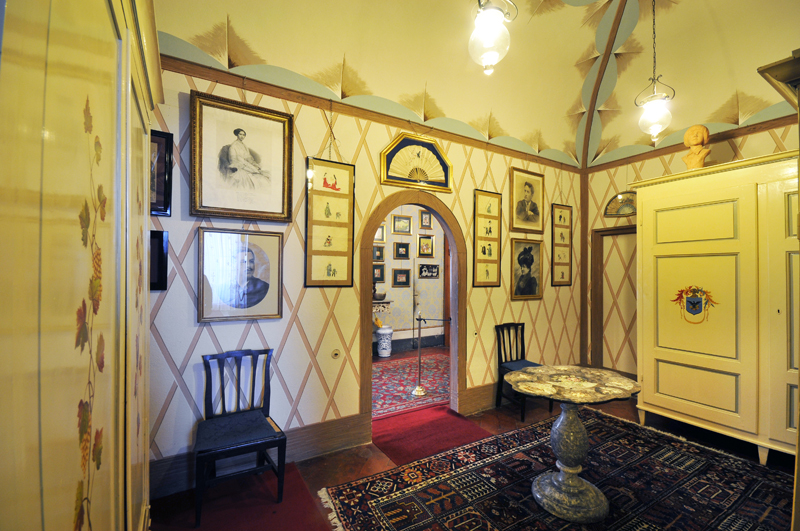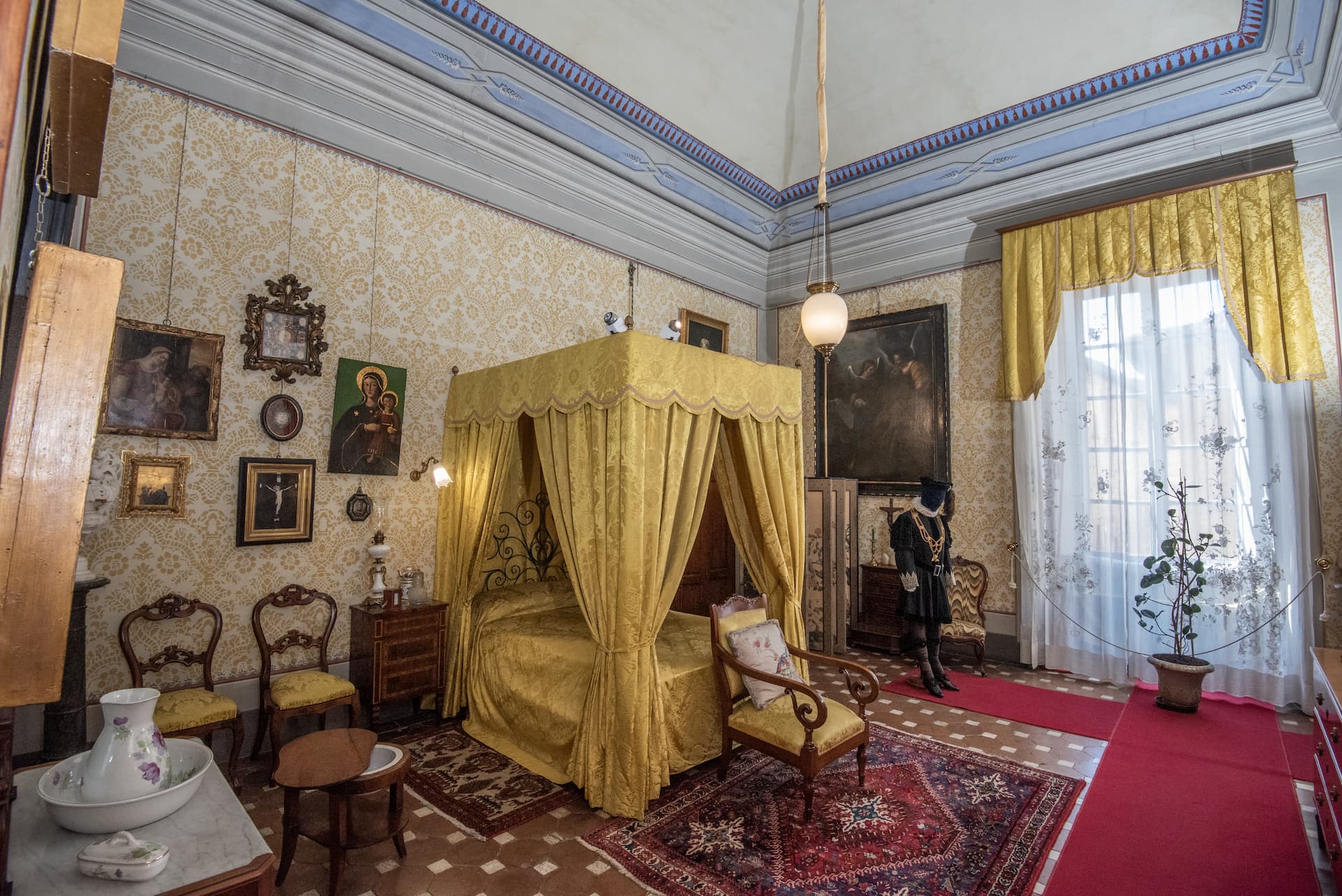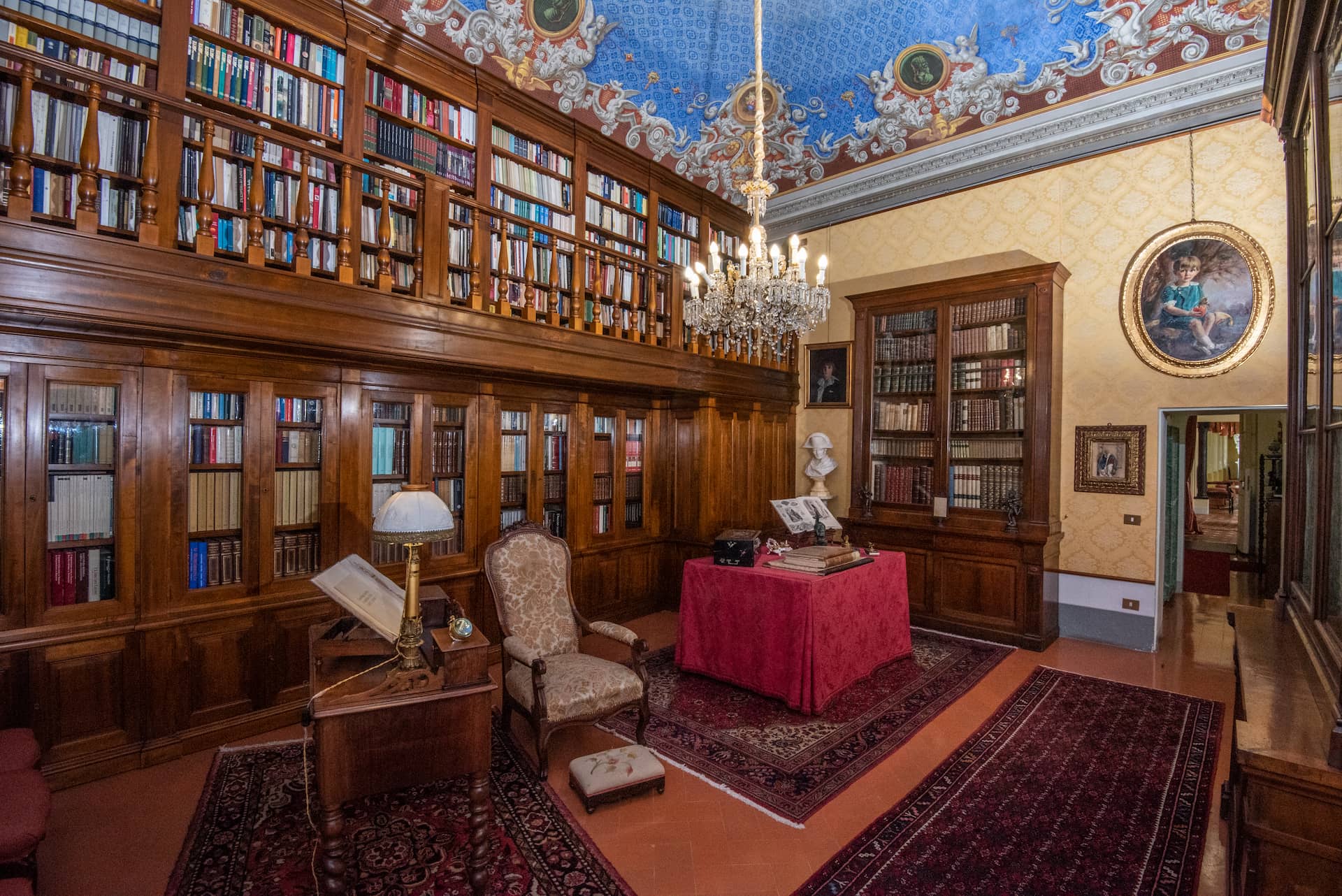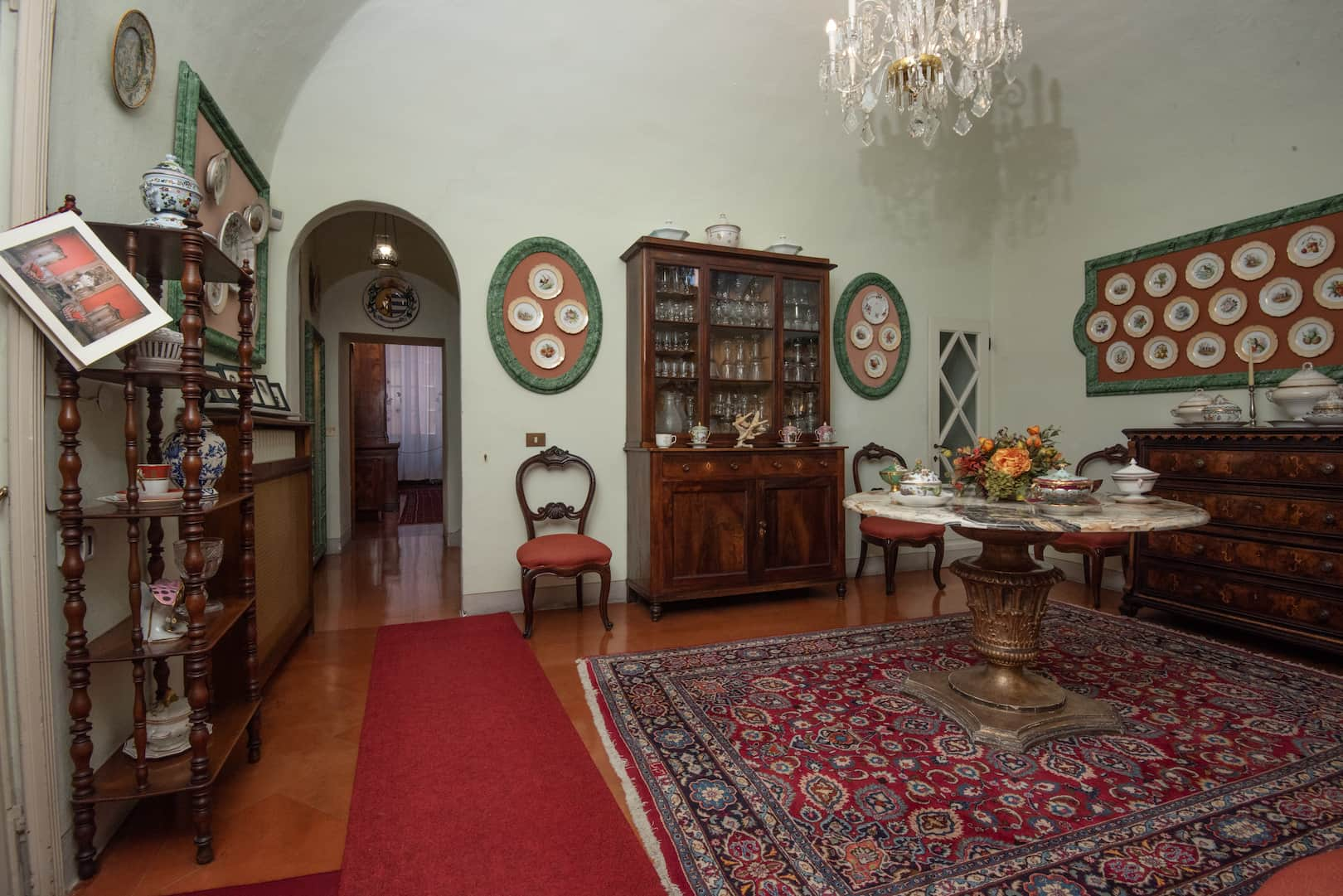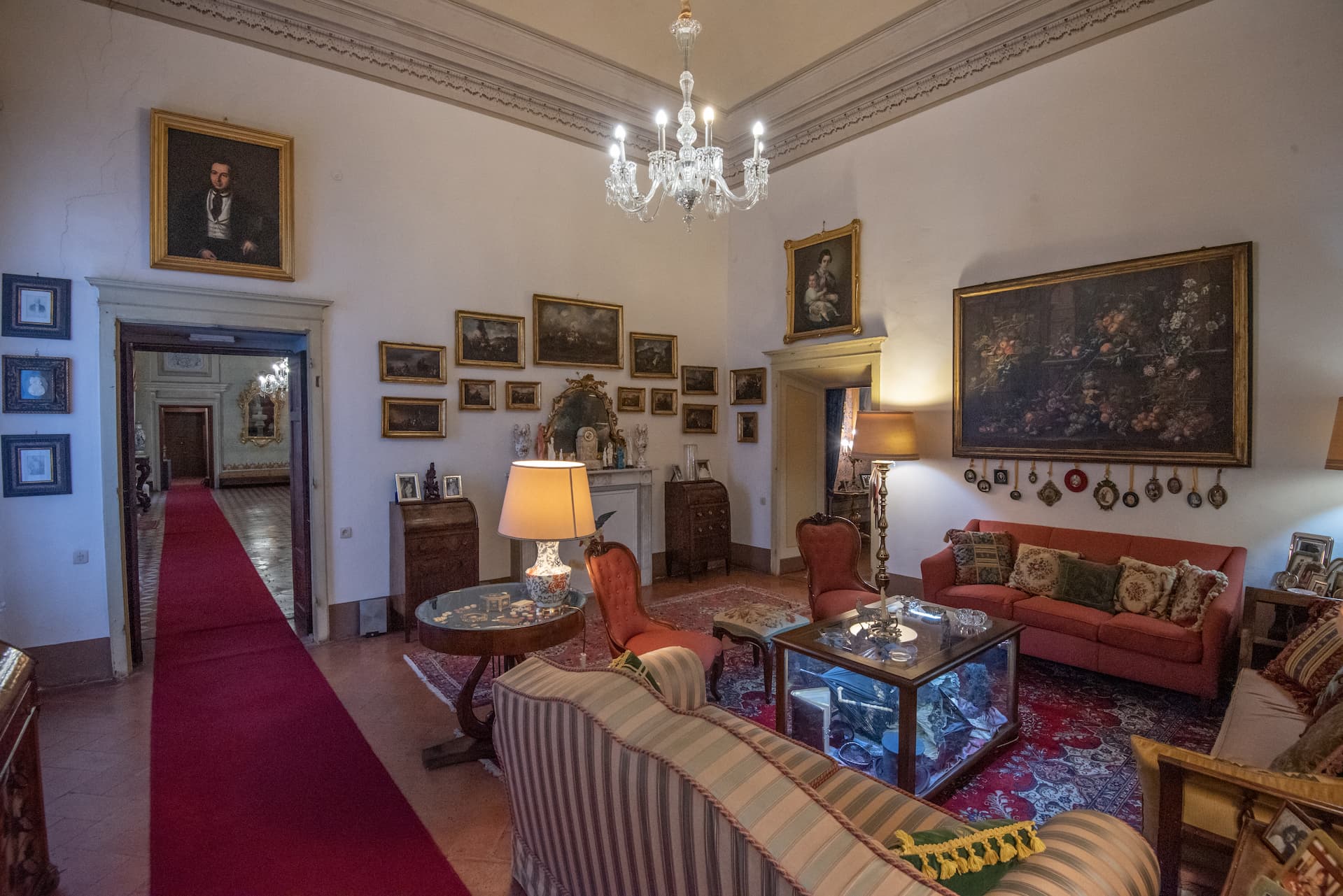It contains 19th-century wardrobes lacquered on the back with heraldic patterns and the family’s coat of arms. The latter has no crown in that the Viti family never accepted a title of nobility on account of their republican convictions. At the centre is a beautiful hardened alabaster table.
Archives: Stanza
Post Type Description
Yellow Room
Above two 18th-century chests of drawers made by the Maggiolini workshop, a beautiful portrait of Carolina Lossetti-Mandelli painted by her nephew A. Baronio in 1890.
Above the dressing-table with old Ginori porcelain is a painting representing Grand Duke of Tuscany Cosimo III as a child and his housekeeper; a masterpiece of G. Sustermans (Anversa 1597-Firenze 1681) a Flemish painter working in Florence in the mid-17th century.
Beside the bed is an important reliquary of various saints, including St Charles Borromeo, archbishop of Milan, an ivory crucifix, a Madonna called “della Penera” – a distemper by an early-15th-century Pisan painter – and two 18th-century Tuscan bedside tables convertible into close-stools. By the window, over the prie-dieu, is a beautiful large 17th-century painting depicting St Francis’s death by G. Martinelli (1600-1659) a Tuscan painter of the 17Th Century and a papal dignitary’s uniform that belonged to Marquis Matteucci Ramirez di Montalvo.
King’s Room
The bed, the room curtains and the tapestry are those that were in use in 1861, when King Victor Emmanuel II visited Volterra. At the centre is a magnificent alabaster table; on the walls, a Virgin and Child by Lucia Anguissola (1542-1565) and a Lady in black by Vittorio Corcos (1859-1933).
The portrait of monsignor was made by A.Barchi (1869-1897). Next to the window is a tent-stitch embroidered portrait of Victor Emmanuel II, and a biblical scene, also embroidered. Underneath are two 18th-century Lombard chests of drawers.
Balcony Room
The glass-fronted sideboard contains Giuseppe Viti’s gold-woven full vizier and emir dresses. The stones on the hats have been replaced with imitations. Opposite is a large cornice with beautiful embroideries representing French missions to India.
The secrétaire has panels made of scaled alabaster and resins. A rich collection of fans and three alabaster mosaic tables are also on show.
On the central table are an important jade elephant used as a parfume container, a scimitar and a jade-handled dagger that belonged to the Emir of Nepal. The painting whit the flowers is by the 18th century Piedmontese painter M.Rapous.
Red Salon
This room features the richest wall decoration in the palace. The furniture is covered in gold foil, with the exception of the inlaid oriental rice-straw cabinet on the right. On the walls, a Sleeping Venus by Antonio Puccinelli (1822-1897) and four portraits: on the right General Andrea de Santa Cruz, president of Bolivia, by the South American painter A. Salas and the alabaster trader Giuseppe Viti, who was created Emir of Nepal and visir by an Indian raja, set in an inlaid alabaster frame; on the left Amerigo Viti and Niccolò Viti, brother and father respectively. At the sides of the window are two old Japanese fabric panels representing the working of tea and silk.
Salon of the Brachettone
Two magnificent Lombard chests of drawers in the Louis XVI style made by Giuseppe Maggiolini (the most famous furniture maker in the 18th century) and two 17th-century ebony cabinets with inlays of ivory. Also notable are a rare walnut burl “trumeau” with inlays of ebonized pear wood and an extremely rare corner cupboard certainly made by the Maggiolini workshop; both are 18th-centuries pieces of Lombard origin.
The three magnificent stained tables with hardened alabaster mosaic tops are unique works of the Viti workshops. On the walls, in front portrait of Dame by Eliseo Sala (Milan 1813-1879) and, on the right, portrait of Lossetti-Mandelli Sisters, by A.Galli, 1906. On the right side there’s a drawing: a sanguine by the Volterran painter Daniele Ricciarelli (Volterra 1509-Roma 1566) called “il Brachettone” (from the Italian term “brache” meaning “pants”) because he covered Michelangelo’s nudes in the Sistine Chapel in Rome. On the left of the trumeau are four small paintings of the Flemish school depicting European fashion and women’s hairdressing in the early 17th century. The picture by the window represents St.Paul the hermit by Salvator Rosa (1615-1673).
Library
It includes two Charles X bookcases with many rare and important books. The large galleried library has been recently made. The paintings hanging on the walls include a portrait of the countess Alessandra Mandelli, daiting 1676.
Above the two doors, the portrait of a child by Lucia Bassani (1896-1977) and the one of an “Old Lady” by Ettore di Maria (1851-1938). Beside the window, portrait of Caterina Picchena (1602-1654).
The ceiling, the most notable in the palace, is decorated by four medallions with the portraits of the greatest Italian poets, Dante, Petrarca, Ariosto and Tasso. On the table in the centre, an outstanding Japanese lacquer and mother-of-pearl travelling escritoire. On the writing desk, an impressed porcelain (lithophane) lamp with a shade, which is the splendid and extremely rare work of the royal manufactories in Berlin.
Room of Porcelains
On the walls, French and English porcelains chosen from the sets in use in the palace. In the wall show window, a valuable collection of puerpera’s bouillon cups.
Exhibition Hall
Great room with fireplace for temporary exhibitions. In the wall show window, a valuable collection of puerpera’s bouillon cups.
Salon of Battles
It is so named because of the thirteen paintings representing battles by various 17th- and 18th-century artists (Rugendas, Bergognone, Graziani, etc.).
At the sides of the fireplace, two 19th-century Tuscan firewood cabinets. The large still lifes are by an 18th-century Piedmontese master. In the corner, on an 18th-century table, an extremely rare Buddhist monk made of red amber, the fossil resin of the cherry tree. By the window, an important 18th-century Lombard bureaux; on the wall, the portrait of Roman emperor Otone, of Tizian’s workshop. The honour medals are the ones conferred to Giovanni Barbavara di Gravellona who was the first General Postmaster of the Italian Kingdom and the promoter of the Universal Postal Union.
A table with a showcase displays a collection of ivories, alabaster medallions and hard oriental stones


